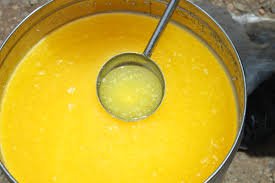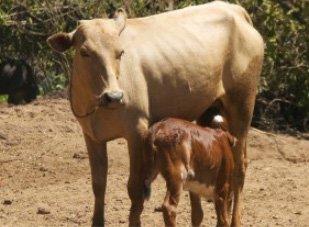Cow Ghee

About Cow Ghee
Cow Ghee or clarified butter consists of 99.9% fat and the rest made of moisture and some fat-soluble vitamins, charred milk protein fractions and others. Saturated fats and cholesterol, form the major components of the fat content of the ghee. Ghee is being used as an alternative to cooking oil in many of the dishes in India and the Middle East. Cow ghee is a delicacy and has got superior status among Indian food. Please note that when we refer to cow ghee we refer to Desi cow ghee. i.e Ghee prepared from milk of desi cows. i.e cows of Indian Origin or A2 milk or Bos indicus.
Preparation of Cow Ghee
Cow ghee preparation is an ancient household art in India. In this method, milk is fermented to curd and the curd is churned until the entire cream is separated into butter which starts floating. The butter is separated, washed well with water until all buttermilk is removed. The pure cleaned butter is heated to boiling and clarified to get the ghee. It is important to stop the heating at a critical level of boiling of the liquefied butter to get the characteristic smell and texture of the cow ghee.
In the commercial method, milk is boiled and cooled to get the creamy layer, which is separated and churned to butter and processed similarly to the traditional method to produce the ghee. The traditional method is followed in the majority of the households which yields a good quality of buttermilk as a by-product and used for different edible purposes. However, the commercial dairy units follow the process of extraction of ghee from the cream of the milk.
Cow Ghee Nutrition
Cow ghee is a good source of omega 3 fatty acid, docosahexaenoic acid (DHA). This is known to be a memory booster. This compound is one of the essential fatty acids and need to be supplied by food, as the human body cannot synthesize it. Fish oil, flaxseeds, and walnuts are the other sources of this fatty acid. Ghee is highly nutritious but branded as the first one to avoid in the anti-obesity drive. This is due to the misleading interpretation of the composition of cow ghee. The quantity of fat content in the ghee is overemphasized, without consideration of the quality of the components. In fact, the DHA deserves special consideration in terms of its nutritious and health benefits but often not gets revealed. The cow ghee also improves the absorption of fat-soluble nutrients, improves memory and nourishes and lubricates the joints. The antioxidant property of the ghee equips it with anti-aging effect making it a superior dietary item, contributing greatly to the wellness.
Cow Ghee for Health and Fitness
As in all other natural sources of medicine and nutrition, Ayurveda did it with cow ghee also! Ayurveda had identified the anti-aging and nourishing activity of cow ghee and recommended it as a food and medicine for centuries. There is an entire range of formulation in Ayurveda named “Ghrita” where cow ghee forms the base to which the medicinal ingredients are added while preparing the drugs for clinical purpose. Ayurveda strongly advocates use of cow ghee for promoting longevity, prevention of many diseases and ailments. The modern science has proved that ghee is rich in fat-soluble vitamins such as vitamin A, D, K and E. These vitamins are known to impart several health benefits. Vitamin A facilitates cellular growth, increases the strength of the teeth and improves bone health. This vitamin is essential for vision and is important in eye care. Vitamin D improves cognition, calcium absorption and prevents inflammation in the body. Vitamin E enhances the wound healing process and tones the immune system. Vitamin K is essential for blood clotting.
The role of DHA in reducing the risk of heart attack, cancer, insulin resistance, arthritis and even mental disorders like Attention Deficit Hyperactivity Disorder (ADHD), confirmed by modern research has added further value to the medicinal potential of cow ghee. In addition to DHA, cow ghee carries Omega-6 Fatty Acid and Conjugated Linoleic Acid (CLA) which is involved in harmonizing the glycemic profile in the human body and the butyric acid present in the ghee makes it an immunomodulatory in action. The cow ghee stimulates gastric juice secretion and stimulates digestion. Further, the CLA in the ghee can be useful in weight loss, as it mobilizes fat cells for the breakdown for energy in the body. In addition, intake of a low dosage of cow ghee has been reported to lower the bad fat, low-density lipoproteins (LDL) and cholesterol. Nutritionists suggest an intake of 2 teaspoons of cow ghee per day for health and fitness including weight loss regimes!!!
Cow Ghee in Rituals
Cow ghee is an inevitable resource in the Hindu rituals. It is considered as divine and used as the major offerings in Havanas, and often used as one of the ingredients in the preparation of recipes meant for offering in Poojas, Havanas and other religious practices.
As mentioned above, please note that cow ghee mentioned in the article refers to Desi cow ghee. Ghee prepared in the right traditional method mentioned in Ayureda. Ghee prepared from milk of Desi Indian cows of Bos Indicus Family. Ghee prepared from curd and not from cream. For buying this type of Ghee which is Amrut please visit our Website.
Help Us Now

Donate to Surabhivana Gaushala to save and protect Indian Cow Breeds.
All donations are exempt under Section 80G of the Income Tax Act, 1961. All donation receipts shall be mailed to the address given by the donor or may be collected in person, at request.
Click the below button to donate through credit cards/debit cards or Net Banking via Razor Pay.
